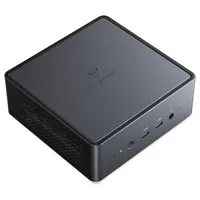TechRadar Verdict
While it doesn’t have a metal case, the M4 ticks every other box for a successful NUC design. The asking price is low, the performance is good, and it’s a highly flexible system that can perform many tasks. Little to dislike here.
Pros
- +
Affordable
- +
Memory and storage upgrades are easy
- +
USB 4.0 port
- +
OcuLink
Cons
- -
No Thunderbolt
- -
All plastic case
Why you can trust TechRadar
Bosgame M4: 30-second review
Ever since Intel decided not to make NUC systems, they’ve been massively popular, ironically.
One of the most popular brands is Bosgame, which, as the name implies, is oriented towards creating hardware that interests gamers.
However, as the M4 hardware covered in this review demonstrates, those credentials are equally relevant to those seeking an NUC-sized system with enhanced graphics performance.
The M4 is a classic scale NUC design built around the AMD Ryzen mobile processor series, with easily upgradable memory and storage. It can be mounted onto the back of a monitor to provide a simple and transportable one-piece solution.
Depending on the specific needs, there is a range of processor options, memory configurations and storage capacities. These range from an entry-level system that utilises the older Ryzen 7 5700U. Above that is a 6000 series Ryzen 7 6800H option, and the flagship of the M4 is a Ryzen 7 8745HS, reviewed here for those who require the best performance.
While it isn’t built to the exacting standards of the discontinued Intel NUC systems, the plastic construction of the M4 is adequate for most uses.
What’s great about this solution is the flexibility it offers with dual 2.5GbE LAN ports, WiFi 6E, a USB 4 port, HDMI and DisplayPort outputs, and even OcuLink.
Sign up to the TechRadar Pro newsletter to get all the top news, opinion, features and guidance your business needs to succeed!
That last port enables a discrete video card to be attached, dramatically enhancing video performance.
Overall, this is an aggressively priced solution with a wide range of uses that’s especially relevant for those who need a small yet powerful system. It's an obvious candidate for our best mini PC round-up.
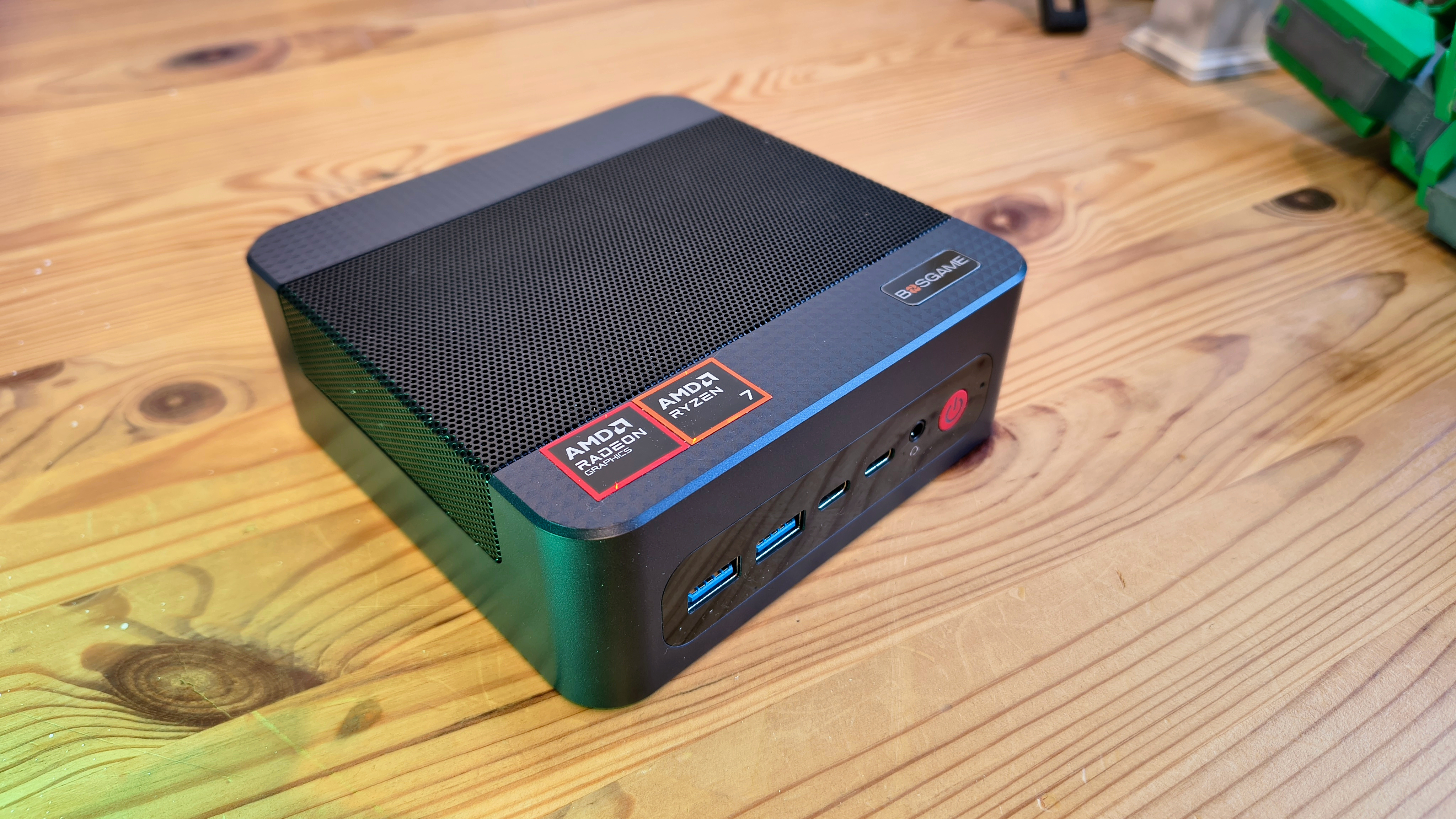
Bosgame M4: Price and availability
- How much does it cost? $440/£370
- When is it out? Available soon
- Where can you get it? It’s available directly from Bosgame or through online retailers like Amazon.
This machine can be purchased from Amazon.co.uk for £439 in the UK and $489.99 in the USA on Amazon.com.
However, the best deal is to obtain it directly from Bosgame. From the maker, the price is £370 for UK customers, $500.09 for US customers, and €438.03 for the EU. There is also free shipping from the US warehouse.
The alternatives include the Beelink SER8, which has the same processor, memory and storage. It costs around $499 in the US, making it a remarkably similar price.
However, the Beelink machine lacks an OcuLink port, rendering it less suitable for those who wish to add an external GPU at a later time.
For the asking price, the M4 is aggressively positioned.
- Value: 4,5 / 5
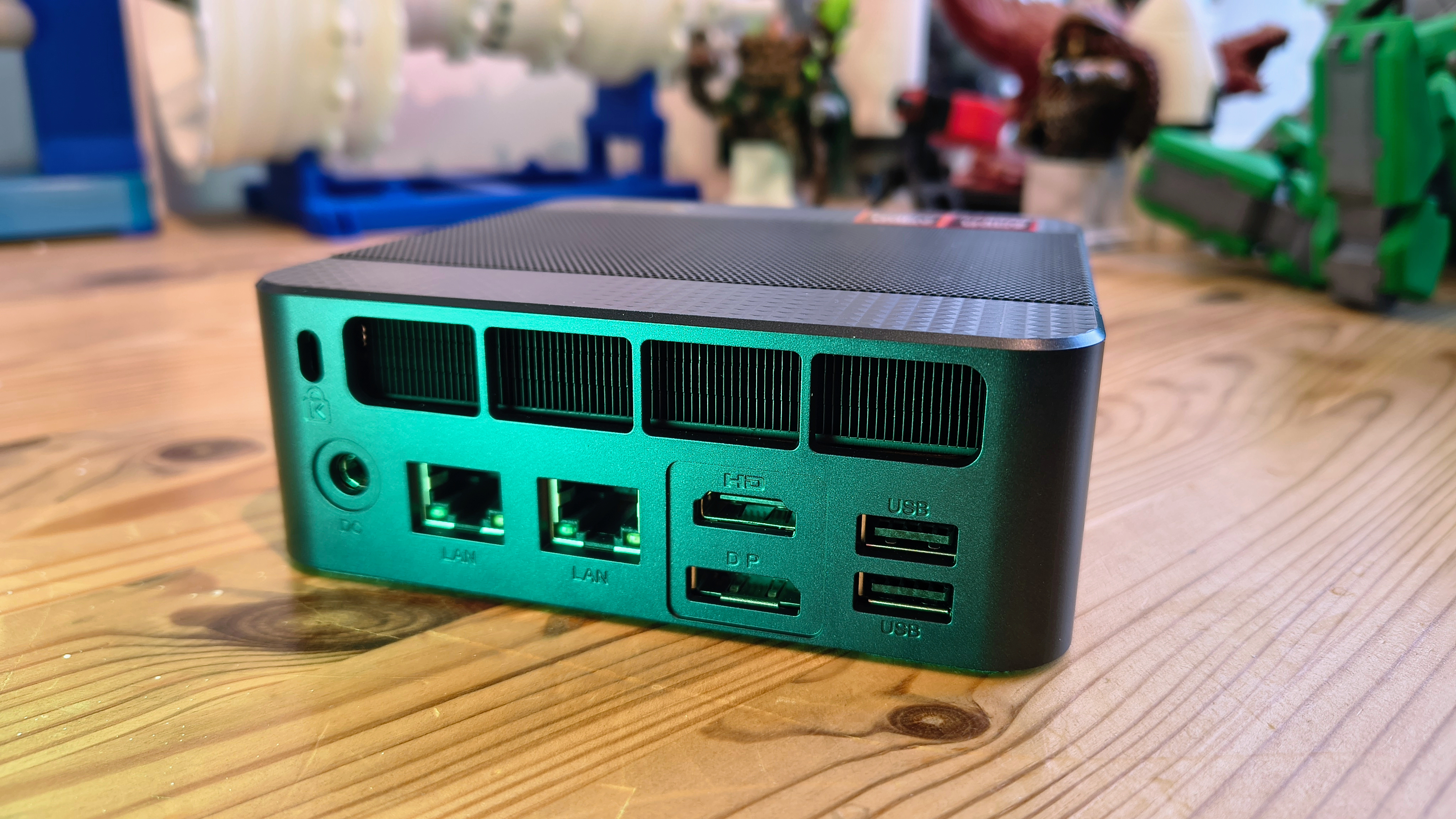
Bosgame M4: Specs
Item | Spec |
|---|---|
CPU: | AMD Ryzen 7 8745HS (8 cores, 15 Threads) |
GPU: | AMD Radeon 780M |
RAM: | 32GB DDR5-5600MHz (16GB x 2) expandable to 64GB (2x 32GB) |
Storage: | 1TB M.2 2280 PCIe Gen 4 |
Expansion: | 1x M.2 2280 is free for expansion, Dual SODIMM memory slots |
Ports: | 2x USB 3.2 Gen 2 Type-A, 1x USB 3.2 Gen 2 USB-C,1x USB 4.0, 2x USB 2.0, 1x HDMI 2.0,1x Displayport 1.4, 1x universal audio jack |
Networking: | 2x 2.5GbE LAN, WiFi 6e, Bluetooth 5.2 |
OS: | Windows 11 Pro (pre-installed) |
Base Power: | 35-54W |
PSU: | 19V 6.3A 119.7W |
Dimensions: | 129 x 129 x 48 (mm) |
Bosgame M4: Design
- Classic NUC
- Straightforward access
- OcuLink and USB 4
When considering the platform and features of this design, it seems implausibly small, measuring just 129mm square and 48mm high.
That’s a classic NUC size, but when Intel made them this small, they typically had a Core i3 processor inside.
Ventilation is arranged so that air is sucked in on the underside and then ejected across a large perforated panel across the top and also via four slots on the rear above the I/O area.
This design choice dictates that access to the internals is from the underside, where just four screws release the bottom plate. With that removed, another three screws must be taken out to detach the heatsink for the NVMe storage, and full access to the memory and SSD is achieved.
Access is more complicated than some designs, but it’s not difficult to do a memory or storage upgrade if you own a small screwdriver. There are two DDR5 SODIMM slots for memory, occupied by two 16GB modules, the branding of which has been obscured. The 1TB NVMe was a Kingston OEM part, and Bosgame was less coy about its origins.
In theory, the maximum memory supported by this Hawk Point processor is 256GB; however, the largest modules widely available are 48GB, which makes 96GB the practical limit.
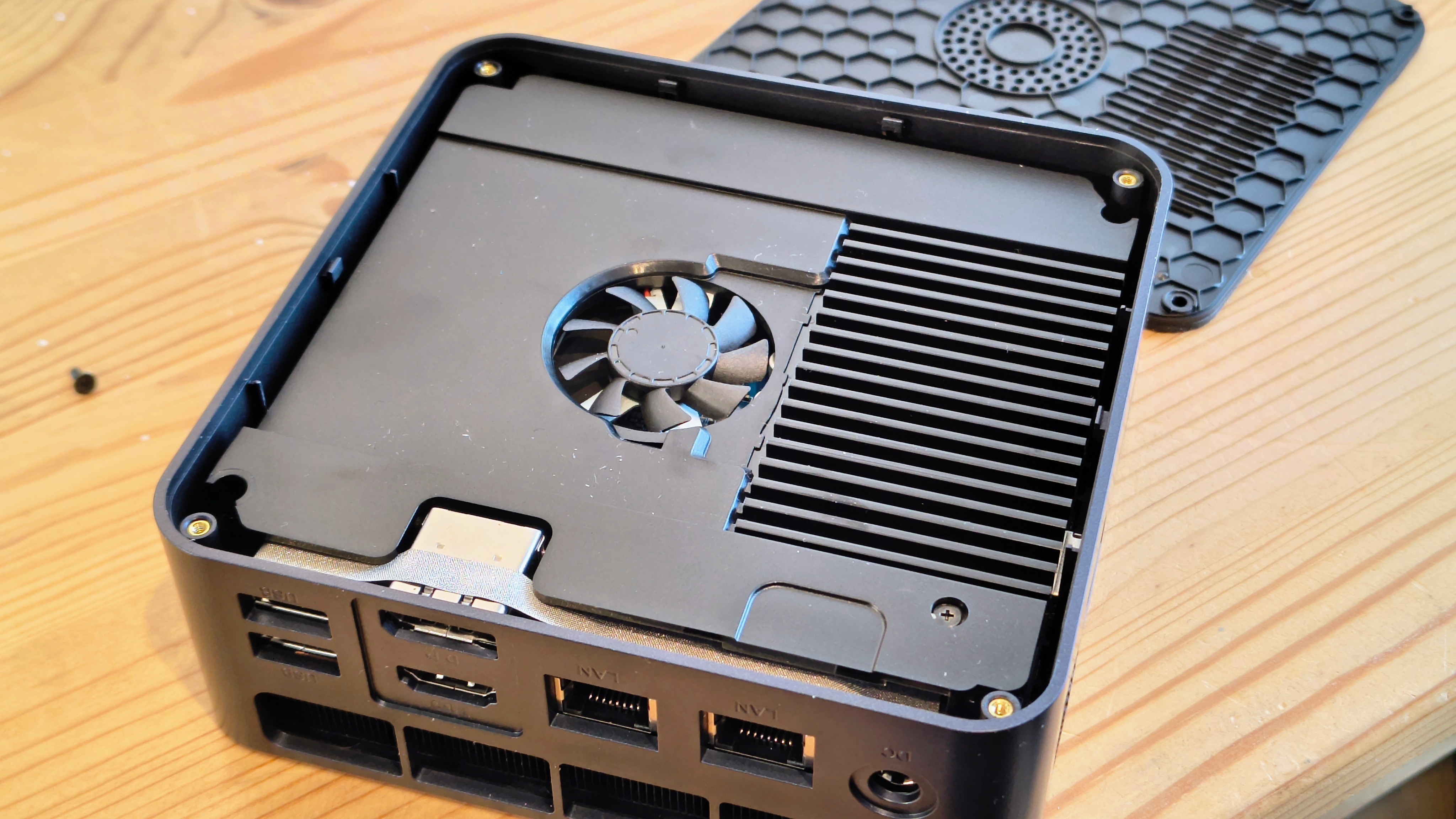
For storage, it would be possible to swap the 1TB drive for a 4TB or 8TB option, and with a free 2280 M.2 slot, that amount could be doubled. The only issue to consider is that the integrated heatsink assumes the NVMe drives don’t have any cooling structures attached.
Having two slots is remarkably useful, even if you are happy to run with the default drive, as you can clone the drive to another, faster, or larger drive without resorting to an external caddy.
I also noticed that the WiFi is supplied on an M.2 2230 card, making it possible to upgrade to WiFi 7 from the WiFi 6e default technology for those who are keen on making those changes.
The port allocation is excellent, with two USB 3.2 Gen 2 ports on the front alongside a USB-C and a USB 4.0. On the rear are two USB 2.0 ports for mouse and keyboard use, HDMI 2.0 and DisplayPort 1.4 outputs, and dual 2.5 GbE LAN ports.
My only gripe about the ports is that the two USB-C type ports on the front have no logos to indicate which of these is the USB 3.2 USB-C or USB 4. It was by trial and error that I determined that the USB 4 is on the right, as the M4 itself provides no clues.
That there is only one USB 4 is understandable when you realise that on the right side is an OcuLink port, which subverts the bandwidth of a USB 4 channel to provide a means to extend the PCIe bus to external devices.
Bosgame features a discrete external video card that utilises OcuLink, specifically the eGPU Docking Station GVP7600, which combines an AMD Radeon RX 7600M XT discrete video card with an additional M.2 slot for storage. That upgrade isn’t inexpensive, but it can significantly enhance the video performance of the base M4.
While I didn’t test any specifically, other external docks link using the OcuLink port, which can accommodate almost any video card. Providing a cost-effective option for those who have an unused discrete GPU to hand.
- Design: 4 / 5
Bosgame M4: Features
- AMD Ryzen 7 8745HS
- USB 4.0
- 20 PCIe lanes
It’s obvious why many mini PC builders are embracing AMD since its parts are cost-effective and they come with ample PCIe lanes, enabling plenty of high-speed ports.
The Ryzen 7 8745HS is a Hawk Point chip that I believe was exclusive to China and never got an official AMD launch when it first appeared at the end of 2024.
As with all Ryzen 7 mobile platforms, this is an eight-core chip with hyperthreading, allowing for sixteen simultaneous threads. It features an enhanced power profile compared to the 8745H model, delivering modestly higher clock speeds.
There are a few positive aspects to this chip, as well as one aspect that’s less than ideal.
The one weakness is the 780M GPU, which is starting to look dated and needs an overhaul if it’s to compete with the next generation of Intel mobile integrated graphics.
On the positive side, this features Zen4 architecture, which is as powerful as the 7745HX from the previous generation. It supports DDR4, DDR5, and the new LPDDR5x memory standards.

However, where it truly shines for mini PC use is the twenty PCIe 4.0 lanes that AMD has equipped it with, enabling numerous ports and potential by definition.
It’s the bandwidth of these lanes that makes USB 4 and OcuLink on this system viable and also enables it to accept dual M.2 2280 Gen 4 SSDs easily.
It achieves all this with a relatively small power footprint, thanks to its design for laptops, which helps it remain cool and quiet during operation.
There are faster Ryzen 9 machines available, some with discrete GPUs, but for general office use, this is a powerful machine that is equivalent to many desktop systems.
- Features: 4 / 5
Bosgame M4: Performance
Mini PC | Header Cell - Column 1 | Bosgame M4 | Chuwi AuBox 8745 |
|---|---|---|---|
CPU | Row 0 - Cell 1 | AMD Ryzen 7 8745HS | AMD Ryzen 7 8745H |
Cores/Threads | Row 1 - Cell 1 | 8C 16T | 8C 16T |
RAM | Row 2 - Cell 1 | 32GB DDR5 (2x16GB) | 16GB DDR5 (1x16GB) |
Storage | Row 3 - Cell 1 | 1TB NVMe Kingston OM8PGP41024N | AirDisk 512GB |
Graphics | Row 4 - Cell 1 | Radeon 780M | Radeon 780M |
3DMark | WildLife | 17746 | 10604 |
| Row 6 - Cell 0 | FireStrike | 7448 | 4600 |
| Row 7 - Cell 0 | TimeSpy | 3126 | 1909 |
| Row 8 - Cell 0 | Steel Nom Lt. | 2559 | 1681 |
CineBench24 | Single | 104 | 101 |
| Row 10 - Cell 0 | Multi | 909 | 857 |
| Row 11 - Cell 0 | Ratio | 8.71 | 8.45 |
GeekBench 6 | Single | 2609 | 2155 |
| Row 13 - Cell 0 | Multi | 12840 | 9205 |
| Row 14 - Cell 0 | OpenCL | 26664 | 23965 |
| Row 15 - Cell 0 | Vulkan | 31667 | 25301 |
CrystalDisk | Read MB/s | 4087 | 3265 |
| Row 17 - Cell 0 | Write MB/s | 3142 | 2810 |
PCMark 10 | Office | 6992 | 6391 |
WEI | Row 19 - Cell 1 | 8.2 | 8 |
There is a moral to this tale, and it’s not to cheap out on memory.
In baseline hardware, the Bosgame M4 and Chuwi AuBox are bedfellows, with the differences between the Ryzen 7 8745HS and H variant being marginal.
Bosgame also opted for a higher-quality SSD, and that’s reflected in the CrystalDiskMark scores.
However, the elephant in the room is memory, specifically the extra bandwidth that dual DDR5 modules provide compared to a single stick, and the massive impact that has on graphics performance.
This is one of the caveats of integrated graphics, as the GPU shares the same memory that the CPU uses, and the bandwidth it has will determine the video performance. In the most extreme circumstances, the M4 is 70% faster than the AuBox because it has dual memory modules.
If we ignore the Chuwi machine, this system is quicker than an Intel NUC running the Core i9 12900H, like the Beelink GT Ultra.
However, the Beelink GTi12 Ultra with an external video card would be quicker again, as would the M4 with an OcuLink-connected GPU.
- Performance: 4.5 / 5
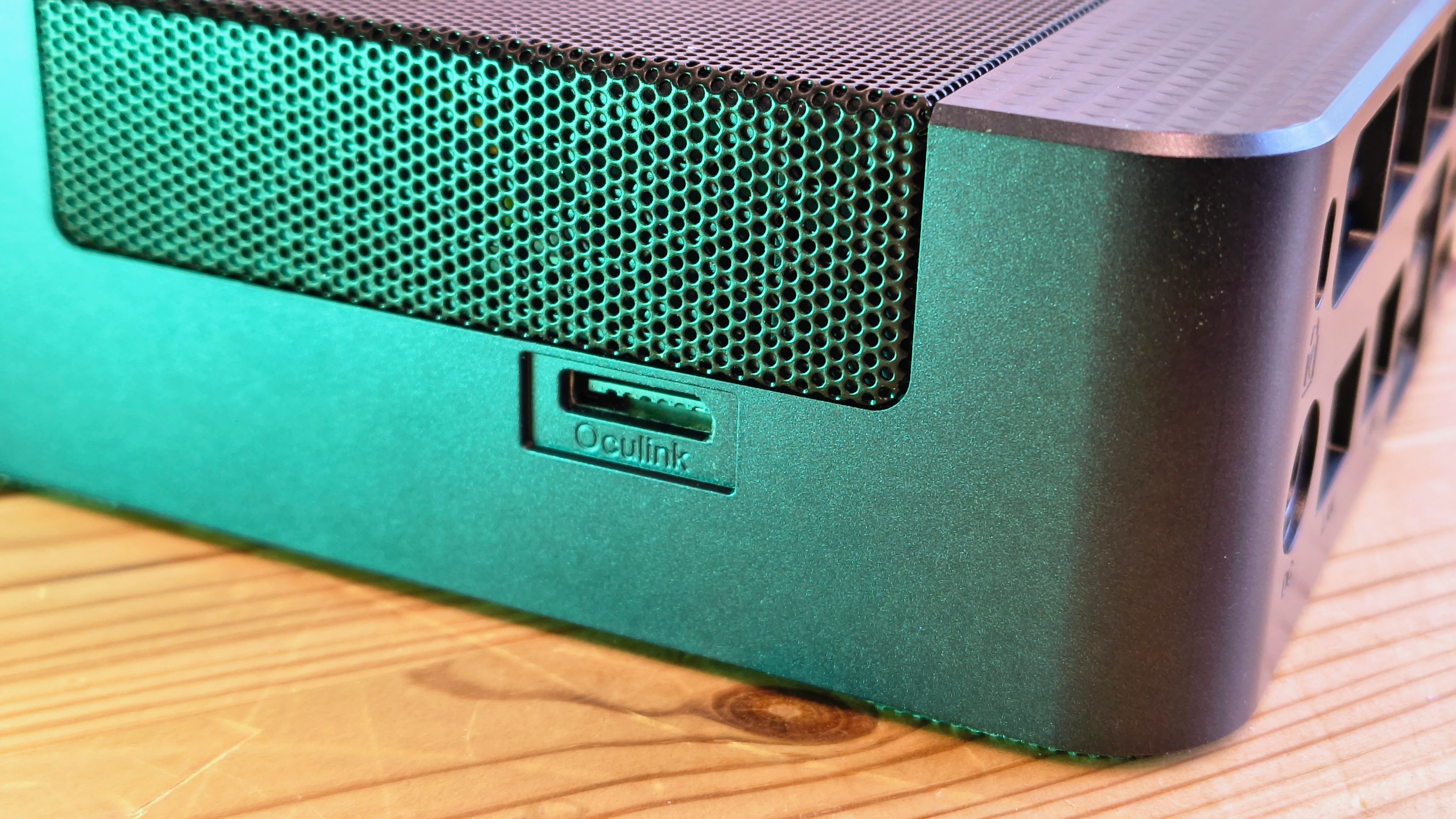
Bosgame M4: Final verdict

When reviewing this sort of device, one of the critical questions is always, “Why wouldn’t you want one of these?” And, having used the M4 extensively, I’m still trying to answer that question.
If I’m hyper-critical, while OcuLink with a decent discrete video card is much better than integrated graphics, a solution like the Beelink GTi12 Ultra, which has an external PCIe slot, is always going to be better at delivering the full GPU performance of a card.
The Beelink machine is a much larger solution that can’t be mounted on a monitor, and it’s also much more expensive.
What the M4 offers is an inexpensive and practical solution that would be of interest to many more customers, and it has some options for those who want more memory, storage or a discrete video card.
There are literally tens of brands making Mini PCs based on the AMD Ryzen, but this one is certainly excellent value for money and appears to avoid the obvious pitfalls we’ve seen on other systems.
For those seeking a modest price and a little more performance, Bosgame also offers an M4 Neo that utilises a Phoenix-class Ryzen 7. However, the difference between this hardware and that will be remarkably subtle.
Should you buy a Bosgame M4?
Value | For the platform, this is a bargain | 4.5 / 5 |
Design | Standard NUC design, with ports front, back and side. | 4 / 5 |
Features | A decent processor, lots of ports and OcuLink | 4 / 5 |
Performance | Snappy performer within the limitations of the 780M GPU | 4.5 / 5 |
Overall | Delivers a flexible and powerful platform for a relatively modest cost | 4.5 / 5 |
Buy it if...
You like computers to be quiet
The airflow of this system is decent without becoming noisy when stressed. If it’s mounted on the back of a monitor, it is practically silent.
You want four monitors connected
With HDMI, DisplayPort, USB 4.0 and USB-C, it is possible to connect four screens to this system. But, be realistic about what you intend to show on those screens simultaneously, because the Radeon 780M is still an integrated GPU that shares system memory.
However, you can add an external GPU via OcuLink.
Don't buy it if...
You need Thunderbolt
While, in theory, USB 4 is equivalent to Thunderbolt, there are some devices that require this specific interface to function fully. If you have a Thunderbolt external SSD that needs TB3 or TB4, then don’t assume it will work. It might, but never assume connectivity.
Also Consider
GMKtec NucBox K8
A very similar design to the M4 is built around almost the same platform. Not easy to source these days, but GMKtec has a K8 Plus model with plenty of stock.
Check out our GMKtec NucBox K8 review
Minisforum UM790 Pro
An even more powerful AMD system using a Ryzen 9-class processor, but the same Radeon 780M GPU. Targeted towards creatives and gamers, the expandable memory and dual M.2 PCIe 4.0 SSDs allow you to boost performance according to your requirements, with the standard version already delivering remarkable capabilities.
Check out our Minisforum UM790 Pro review
For more professional hardware, we've reviewed the best business computers.
Mark is an expert on 3D printers, drones and phones. He also covers storage, including SSDs, NAS drives and portable hard drives. He started writing in 1986 and has contributed to MicroMart, PC Format, 3D World, among others.
You must confirm your public display name before commenting
Please logout and then login again, you will then be prompted to enter your display name.


